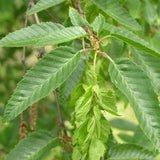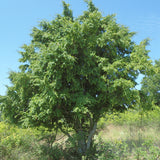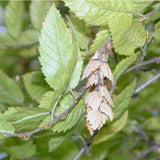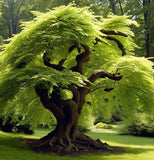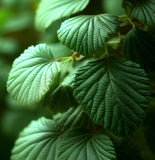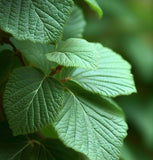Carpinus orientalis (Oriental Hornbeam)
Carpinus orientalis (Oriental Hornbeam) is a deciduous tree native to regions of southeastern Europe, including Greece, Turkey, and parts of the Balkans. It is also found in southwestern Asia, particularly in Iran and the Caucasus. It prefers well-drained soils and is commonly found in woodlands and forested areas.
Appearance: Oriental Hornbeam is a medium-sized tree that typically grows to a height of 40 to 60 feet (12 to 18 meters). It has a rounded crown with dense foliage. The leaves are oval-shaped, serrated at the edges, and have prominent veins. In the fall, the foliage turns shades of yellow, orange, and red, providing attractive autumn color.
Landscape Use: Oriental Hornbeam is valued for its ornamental characteristics and is often used in landscaping. It is suitable as a shade tree, specimen tree, or for creating hedges and screens. Its dense foliage provides privacy, and it can be pruned and shaped into formal or informal hedges.
Foliage and Bark: The foliage of Oriental Hornbeam is dense and dark green, creating a lush appearance. The leaves typically measure 2 to 4 inches (5 to 10 centimeters) in length. The bark is smooth and gray when young, but as the tree ages, it develops shallow fissures and a textured, flaky appearance.
Flowers and Fruits: Oriental Hornbeam produces inconspicuous flowers in spring, usually in the form of small catkins. The female flowers give rise to winged fruits known as samaras, which mature in late summer or early fall. The samaras are papery and tan in color, and they persist on the tree for some time.
Tolerance and Maintenance: Oriental Hornbeam is known for its adaptability to different soil types, including clay and loam. It prefers full sun to partial shade. Once established, it is relatively low-maintenance, requiring minimal pruning and regular watering during dry periods.
Environmental Benefits: Oriental Hornbeam provides habitat and food for various wildlife, including birds and small mammals. Its dense foliage offers shade and helps to reduce soil erosion.
Botanical Name : Carpinus orientalis
Common Name : Oriental Hornbeam
Height : 15’- 25 ft
Spread : 15 ft
Germination Info : Seed requires 30-60 days warm stratification followed by 60-120 days cold stratification
Hardiness zone : 5-7
Average seed per ounce : Approx. 750








